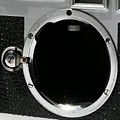Top Qs
Timeline
Chat
Perspective
Leica M mount
Lens mount introduced in 1954 From Wikipedia, the free encyclopedia
Remove ads
The Leica M mount is a camera lens mount introduced in 1954 with the Leica M3, and a range of lenses. It has been used on all the Leica M-series cameras and certain accessories (e.g. Visoflex reflex viewing attachment) up to the current film Leica M-A and digital Leica M11 cameras.
This lens mount has also been used by Epson, Ricoh, Minolta, Konica, Cosina Voigtländer, Rollei, Carl Zeiss AG and Rollei Fototechnic on some of their cameras.[1]
Remove ads
Overview
Summarize
Perspective
The Leica M mount was introduced in 1954 at that year's Photokina show, with the Leica M3 as its first camera. The 'M' stands for Messsucher or rangefinder in German. This new camera abandoned the M39 lens mount in favour of a new bayonet mount. The bayonet mount allowed lenses to be changed more quickly and made the fitting more secure. Other innovations introduced by the M3 included a single window for the viewfinder (for composition) and the rangefinder (for focusing). With a double-stroke film advance lever (later models have a single-stroke lever). The M3 was a success and over 220,000 units were sold, by the time production ended in 1966. It remains the best-selling M mount camera ever made. The M3 uses 135 film (or 35 mm film), with the canister being loaded behind a detachable bottom plate. The M3 was followed by many other M mount cameras, released over 40 years, with many of the basic concepts remaining in these designs. With the introduction of the Through-the-lens metering (TTL) in the Leica M5 and the digital Leica M8 being the most notable innovations since then.[2]
The lenses for the M mount were also introduced in 1954 and were based on the earlier M39 thread mount. Almost all M mount lenses are Prime lenses. These lenses are divided by Leica based on their maximum aperture number (also known as f-number). They are distinguished by their names:[2]
- M mount female part of the bayonet on a Leica M3 body. The mechanical sensor seen inside the top of the mount is the rangefinder coupling arm
- M mount male part of the bayonet on the Leica Elmar 90mm f/4.
- The Leica M3 shutter speed dial, film advance lever, shutter button and the frame counter.
- The Leica M3 ASA dial, purely decorative reminder of the Film speed showing DIN and ASA comparison dial.
- Leica "red dot" logo.
Remove ads
M Mount camera bodies
Summarize
Perspective
Film cameras
Digital cameras
Professional
Entry-Level
Monochrom
No display
Increased resolution
Other manufacturers
- Epson R-D1 by Epson
- Minolta CLE by Minolta
- Hexar RF by Konica
- Bessa R2A, R3A, R2M, R3M, R4M and R4A by Cosina Voigtländer
- Rollei 35 RF by Rollei Fototechnic
- Recent Zeiss Ikon rangefinder camera by Carl Zeiss AG
- Ricoh GXR by Ricoh
- PIXII by Pixii SAS
Remove ads
M mount lenses
Other manufacturers
See also
Wikimedia Commons has media related to Leica M.
Wikimedia Commons has media related to Leica M lenses.
References
External links
Wikiwand - on
Seamless Wikipedia browsing. On steroids.
Remove ads




























